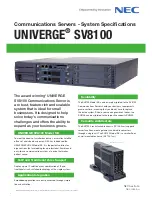
Chapter
5.
Diagnostics
This
chapter
describes
the
diagnostic
tools
that
are
available
to
help
you
solve
problems
that
might
occur
in
the
blade
server.
Note:
The
blade
server
uses
shared
resources
that
are
installed
in
the
BladeCenter
unit.
Problems
with
these
shared
resources
might
appear
to
be
in
the
blade
server
(see
“Solving
shared
BladeCenter
resource
problems”
on
page
108
for
information
about
isolating
problems
with
these
resources).
See
the
Problem
Determination
and
Service
Guide
or
the
Hardware
Maintenance
Manual
and
Troubleshooting
Guide
for
your
BladeCenter
unit
and
other
BladeCenter
component
documentation
for
diagnostic
procedures
for
shared
BladeCenter
components.
If
you
cannot
locate
and
correct
the
problem
using
the
information
in
this
chapter,
see
Appendix
A,
“Getting
help
and
technical
assistance,”
on
page
115
for
more
information.
Diagnostic
tools
The
following
tools
are
available
to
help
you
diagnose
and
solve
hardware-related
problems:
v
POST
beep
codes,
error
messages,
and
error
logs
The
power-on
self-test
(POST)
generates
beep
codes
and
messages
to
indicate
successful
test
completion
or
the
detection
of
a
problem.
See
“POST”
for
more
information.
v
Troubleshooting
tables
These
tables
list
problem
symptoms
and
actions
to
correct
the
problems.
See
“Troubleshooting
tables”
on
page
80
for
more
information.
v
Light
path
diagnostics
Use
the
light
path
diagnostics
to
diagnose
system
errors
quickly.
See
“Light
path
diagnostics”
on
page
93
for
more
information.
v
Diagnostic
programs,
messages,
and
error
codes
The
diagnostic
programs
are
the
primary
method
of
testing
the
major
components
of
the
blade
server.
These
programs
are
stored
in
read-only
memory
(ROM)
on
the
blade
server.
See
“Diagnostic
programs,
messages,
and
error
codes”
on
page
97
for
more
information.
POST
When
you
turn
on
the
blade
server,
it
performs
a
series
of
tests
to
check
the
operation
of
the
blade
server
components
and
some
optional
devices
in
the
blade
server.
This
series
of
tests
is
called
the
power-on
self-test,
or
POST.
If
a
power-on
password
is
set,
you
must
type
the
password
and
press
Enter,
when
prompted,
for
POST
to
run.
If
POST
is
completed
without
detecting
any
problems,
a
single
beep
sounds,
and
the
blade
server
startup
is
completed.
If
POST
detects
a
problem,
more
than
one
beep
might
sound,
or
an
error
message
is
displayed.
See
“Beep
code
descriptions”
on
page
52
and
“POST
error
codes”
on
page
63
for
more
information.
©
Copyright
IBM
Corp.
2007
51
Содержание 8853L6U
Страница 1: ...BladeCenter HS21 Types 1885 and 8853 Problem Determination and Service Guide...
Страница 2: ......
Страница 3: ...BladeCenter HS21 Types 1885 and 8853 Problem Determination and Service Guide...
Страница 8: ...vi BladeCenter HS21 Types 1885 and 8853 Problem Determination and Service Guide...
Страница 16: ...xiv BladeCenter HS21 Types 1885 and 8853 Problem Determination and Service Guide...
Страница 30: ...14 BladeCenter HS21 Types 1885 and 8853 Problem Determination and Service Guide...
Страница 145: ......
Страница 146: ...Part Number 49Y0053 Printed in USA 1P P N 49Y0053...
















































